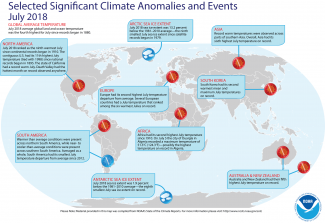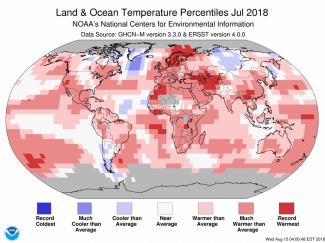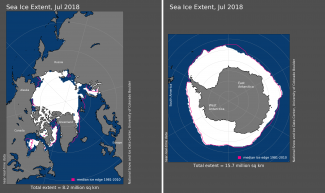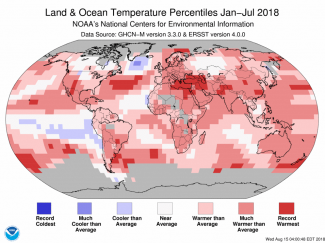Globally, fourth warmest July and year-to-date on record

The global land and ocean temperature departure from average for July 2018 was the fourth highest for the month of July in the NOAA global temperature dataset record, which dates back to 1880. The year-to-date (January-July) global temperature was also the fourth warmest such period on record.
This monthly summary, developed by scientists at NOAA's National Centers for Environmental Information, is part of the suite of climate services NOAA provides to government, business, academia and the public to support informed decision-making.
July 2018 Temperature
-
The July temperature across global land and ocean surfaces was 1.35°F above the 20th century average of 60.4°F, the fourth highest for July in the 1880-2018 record. Nine of the 10 warmest Julies have occurred since 2005, with the last four years (2015-2018) being the four warmest on record. The record warmest July occurred in 2016, with a temperature departure from average of +1.58°F. The year 1998 is the only year from the 20th century among the 10 warmest Julies on record. July 2018 also marks the 42nd consecutive July and the 403rd consecutive month with temperatures, at least nominally, above the 20th century average.
-
Record warm July temperatures were present across Scandinavia and surrounding Arctic Ocean, northwestern Africa, parts of southern Asia, as well as some areas across the oceans and southwestern contiguous United States. No land or ocean areas had record cold July temperatures.
-
-
The globally averaged land surface temperature for July 2018 was 1.93°F above the 20th century average of 57.8°F. This value was the fifth highest July land temperature in the 139-year record.
-
Europe had its second warmest July since continental records began in 1910, at 4.19°F above average, trailing behind 2010 by only 0.02°F. July 2018 marks the third time in the 109-year record that the European July temperature departure from average was 3.6°F or higher. Several European countries had a July temperature that ranked among the five warmest Julies on record.
-
-
The July globally averaged sea surface temperature was 1.12°F above the 20th century monthly average of 61.5°F – tying with 2013 as the sixth highest global ocean temperature for July in the record.
July 2018 Sea Ice
-
The July average Arctic sea ice extent was the ninth smallest in the 40-year record, at 483,000 square miles (13.2 percent) below the 1981-2010 average, according to analysis by the National Snow and Ice Data Center using data from NOAA and NASA. The Arctic sea ice extent retreated rapidly during the second half of July with below-average ice coverage observed in the Barents, Kara, Laptev, East Greenland, and Chukchi Seas. Near-average ice coverage persisted in the Beaufort and East Siberian Seas.
-
Antarctic sea ice extent during July was 110,000 square miles (1.9 percent) below the 1981-2010 average, the eighth smallest July extent on record. Antarctic sea ice expanded at a rate faster than average during the first half of July, but slowed during late July. Near-average sea ice coverage was observed for most areas around Antarctica, with below-average ice occurring north of Wilkes Land and Queen Maud Land.
Year-to-Date (January-July 2018)
-
The year-to-date temperature across global land and ocean surfaces was 1.39°F above the 20th century average of 56.9°F – the fourth highest for January-July in the 139-year record. The 2018 year-to-date value was 0.48°F lower than the record high set in 2016.
-
Record warm January-July temperatures were present across portions of the global oceans as well as parts of the Mediterranean Sea and surrounding areas. New Zealand, and small areas across North America, South America, and Asia also had record warm year-to-date temperatures. No land or ocean areas had record cold January-July temperatures.
-
-
The year-to-date globally averaged land surface temperature was 2.16°F above the 20th century average of 46.8°F. This value was also the fourth highest for January-July in the record.
-
Europe, Africa, Asia and Oceania had a January-July temperature that ranked among the six highest such periods since continental records began in 1910.
-
-
The year-to-date globally averaged sea surface temperature was 1.10°F above the 20th century average of 61.0°F. This value tied with 2010 as the fourth highest for January-July in the 1880-2018 record.
For a more complete summary of climate conditions and events, see our July 2018 Global Climate Report.







